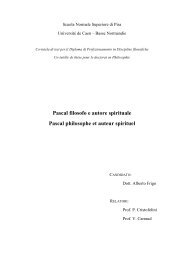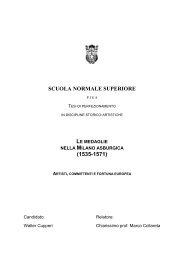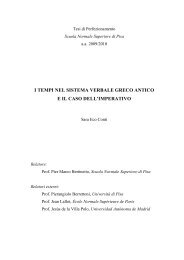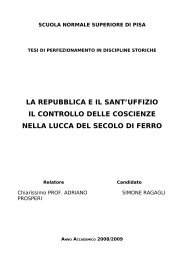CATULLUS 68 - Scuola Normale Superiore
CATULLUS 68 - Scuola Normale Superiore
CATULLUS 68 - Scuola Normale Superiore
Create successful ePaper yourself
Turn your PDF publications into a flip-book with our unique Google optimized e-Paper software.
uiri Lesbia’s uir re-appears at 83.1 Lesbia mi praesente uiro mala plurima dicit. Who is he? According to<br />
the OLD, the word uir can mean both ‘husband’ (s.v., 2a) and ‘lover’ (2b). Could Lesbia’s uir be her<br />
boyfriend or her partner rather than her husband? The odds are against this. While one does come across the<br />
latter use in passages such as Prop. 1.6.9f. illa minatur / quae solet ingrato tristis amica uiro and Mart.<br />
10.<strong>68</strong>.7f. lectulus … quem lasciuo strauit amica uiro, the former use is much more common and is the only<br />
one attested in Catullus (14x, also in lines 80 and 130). It was probably common enough to be the default<br />
meaning of the word: if a Roman heard about a woman and her uir, in the absence of other information he<br />
will have assumed that he was her husband: compare Sal. Cat. 25.2 uiro liberis satis fortunata fuit ‘she was<br />
lucky enough on account of her husband and her children’. Nor is there any sign that uir could be used to<br />
describe a partner in a long-term extra-marital relationship, as could amator; in fact the two words are<br />
contrasted at Ov. Tr. 2.371f. adultera, de qua / inter amatorem pugna uirumque fuit. Lesbia’s uir, then, must<br />
be her husband.<br />
Catullus shows less concern for this man than for Lesbia’s numerous lovers, and he in turn feels a great<br />
satisfaction when he hears Lesbia denounce her former lover Catullus (poem 83). Evidently he is aware of<br />
having only a tenuous hold over her.<br />
147f. It is enough for Catullus if Lesbia meets her on the days she marks ‘with a whiter stone’. The Romans<br />
appear to have marked special days on their wall-calendars with white chalk, witness 107.6 o lucem<br />
candidiore nota! and Hor. Od. 1.36.10 Cressa ne careat pulchra dies nota with Nisbet & Hubbard (1970) ad<br />
loc. A comparable, if slightly eccentric wall-calendar is described at Petron. 30.3f. duae tabulae in utroque<br />
poste defixae, quorum … altera lunae cursum stellarumque septem imagines pictas [i.e. habebat inscriptos]<br />
et qui dies boni quique incommodi essent, distinguente bulla notabantur.<br />
The comparative candidiore indicates Catullus’ “willingness to compromise” (Clarke 2003: 60). He does not<br />
expect to be the only lover of Lesbia; he only hopes that she will mark her appointments with him ‘with<br />
whiter chalk’ than those with her other lovers – that is, she will consider them special, she will prefer him to<br />
the rest.<br />
148 lapide … candidiore candidus ‘gleaming white’ aptly describes white chalk, but the colour white<br />
was generally associated with luck, well-being and good omens in the same way that black (niger, ater) was<br />
and is still associated with misfortune: compare Prop. 2.15.1 o me felicem! o nox mihi candida! (‘happy’ and<br />
not ‘bright’, pace Clarke 2003: 60) and 4.1.67f. Roma, faue, tibi surgit opus, data candida, ciues, / omina et<br />
inceptis dextera cantet auis! as well as Ov. Pont. 4.4.18 candidus et felix proximus annus erit. See further<br />
Clarke (2003: 59-61), OLD s.v., 7a and TLL 3.244.28-43.<br />
diem The principal MSS read dies; diem is a conjecture from the late 15 th century that has been adopted by<br />
most recent editors, though not by Mynors or Quinn. dies would have to go with is in the previous line,<br />
which would result in a violent hyperbaton. Hyperbaton is not impossible per se in Catullus – commentators<br />
compare 44.8f. non immerenti quam mihi meus uenter, / dum sumptuosas appeto, dedit, cenas – but as Goold<br />
244






